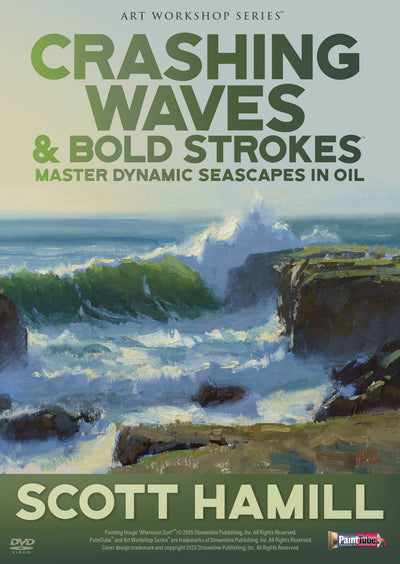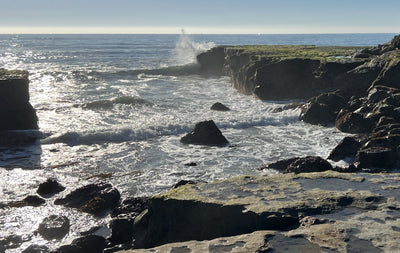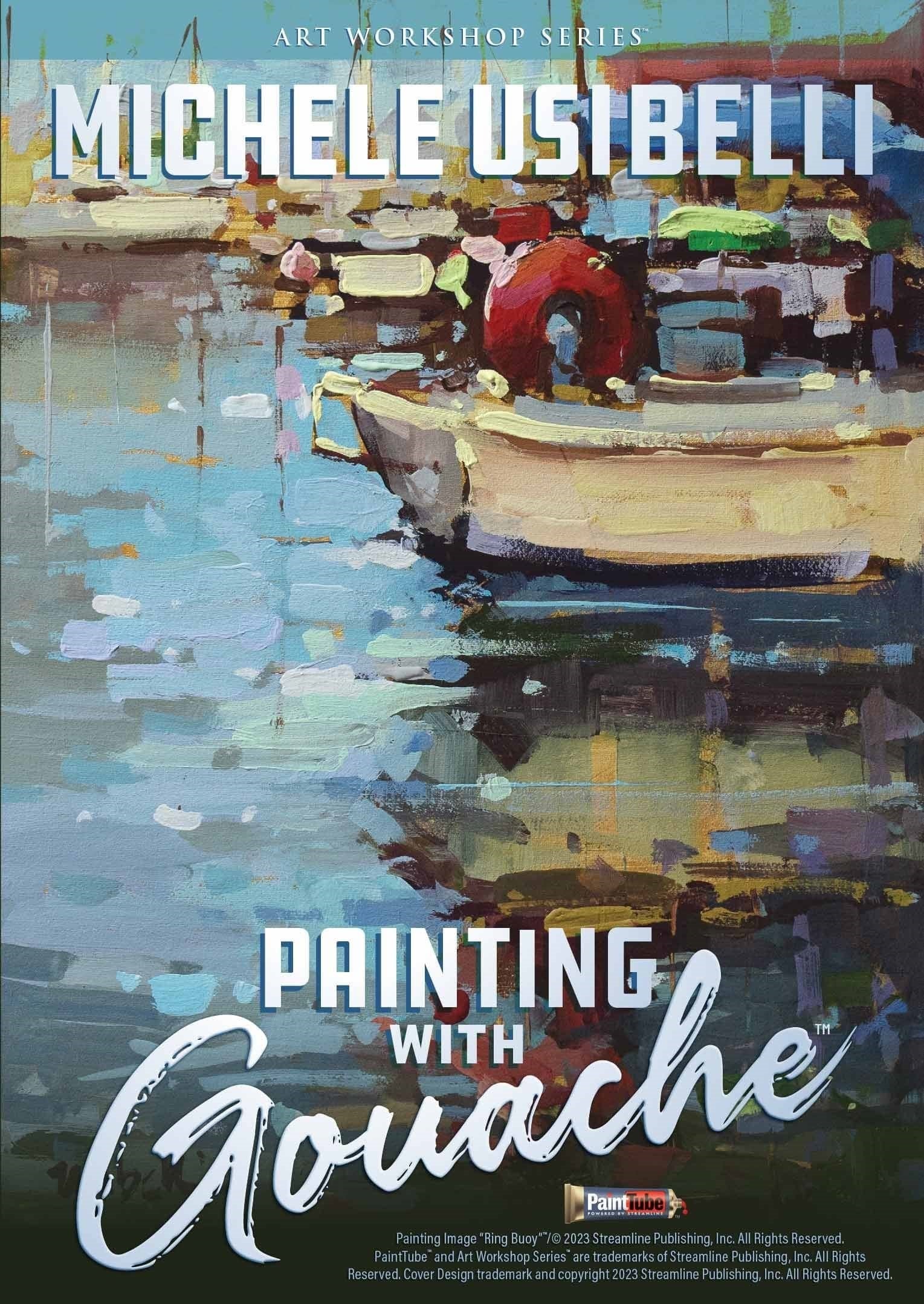Master Loose, Energetic Seascapes With a Surfer's Understanding of Wave Anatomy!
If you’ve ever stood before your canvas, brush in hand, trying to capture the dynamic power of crashing waves…
…only to end up with something that looks awkward and unnatural…
…then it’s time to listen to someone who has spent a lot of time studying water!
The #1 issue with “awkward-looking” waves or seascapes is that you’re likely painting what you think waves look like, rather than understanding how water actually moves.
Too many artists who don’t understand ocean and wave anatomy create odd and uncomfortable-looking work that makes it hard for viewers to relate to the piece.
Scott Hamill has spent a lifetime in and around the ocean — surfing and painting along the Pacific Coast and developing a deep connection to the water.
Because of this, he has unique insight into the ocean's energy and how it moves.
Inside Crashing Waves & Bold Strokes, Scott will help you understand the dynamic movement of the ocean and waves while showing you the techniques he uses to create impressionistic paintings that have both energy and realism.
His approach is refreshingly different.
You’ll learn to paint with loose, energetic brushstrokes that bring your seascapes to life, letting you have fun while creating work that reads accurately to viewers!
Meet Your New Instructor, Scott Hamill!
As a native Californian, Scott Hamill has lived most of his life in and around the ocean and mountains of this beautiful state.
He has developed a strong connection to the water and land while surfing along the Pacific Coast and fishing, backpacking, and canoeing in the Sierra Nevada Mountains.
In his paintings, Scott hopes to capture the mood or essence of a place and allow the viewer to experience the beauty of our natural world.
He uses a limited palette of colors in oils, which helps harmonize the painting as well as adding the challenge of mixing all other colors from these few.
Scott’s painting gear fits into a backpack, allowing him the freedom to get off the beaten path while scouting for locations to capture on canvas when painting en plein air.
Scott’s artwork has been juried into a number of exhibitions and shows throughout the country, and he is honored to have his work in private collections throughout the U.S. and abroad.
When not creating his own art, Scott enjoys sharing his painting experience and techniques through several plein air painting workshops throughout the year.
What makes Scott’s teaching style unique?
His students describe his approach as passionate, energetic, and thorough.
As one student puts it: “Scott meets the students where they are at. His clear, ‘action-packed’ information is communicated with ease and humor. He works with well thought out, purposeful brushstrokes, creating ‘alive’ resonating color.” — Jéanne W Tudor-Collins
Another student shares: “Scott is one of those people whom others like immediately: open, warm, funny, and smart. Somehow he makes each person he works with feel like he or she is the only person Scott is interested in — and he manages to do this with every student, day after day.” — Barrett Edwards
Get ready to experience Scott’s dynamic teaching style as he helps you translate the power and beauty of the ocean onto canvas!
Here’s a small taste of what’s inside Crashing Waves & Bold Strokes: Master Dynamic Seascapes in Oil:
● Watch Scott Hamill’s complete A-to-Z approach to painting stunning seascapes…
● Scott’s life-changing insight: why understanding wave anatomy is the key to creating seascapes that feel authentic and draw viewers in…
● The essential “one brush technique” that Scott uses for 90 percent of his paintings — his “SECRET WEAPON” that allows for bold, energetic brushwork…
● How to “squint for the glint” — Scott’s technique for quickly identifying the proper value structure in ocean scenes…
● Why most ocean paintings look odd and uncomfortable — and how to avoid the common mistakes that disconnect viewers from your art…
● The surprising way to maintain loose, energetic brushwork while still creating realistic-looking waves that accurately capture water movement…
● Scott’s unique approach to avoiding “dead color” in your seascapes — bringing vibrant life to your ocean scenes…
● How to design compositions using dark and light patterns that naturally guide viewers’ eyes to your focal point…
● The Mick Jagger principle: “The focal point is your Mick Jagger of the Rolling Stones” — how to make your focal point stand out…
● Techniques to make your paint application feel spontaneous and free while maintaining control of your composition…
● The surprisingly simple way to keep your ocean from looking “choppy, like broken glass” — a common mistake many artists make…
● How to create a painting that looks like a real wave or photo from a distance, while preserving chunky brushwork and looseness when viewed up close…
● The “Ultimate Goal” of seascape painting — how to make someone look at your work and FEEL the day exactly as you did…
● Scott’s technique for creating depth in your paintings because, he says, “The goal is that you want to feel you can reach your arm into the painting”...
● How to paint mist and air, adding atmosphere that makes your seascapes breathe…
● The “Counterintuitive Connection”: “How painting an exploding crashing wave is like painting a cloud”...
● How to use atmospheric perspective and edges to create convincing distance in your seascapes…
● Scott’s solution to keep rocks from looking like they’re floating, addressing a question he is frequently asked...
● The painterly technique that “helps your viewers invest themselves in your painting as they fill in the gaps”...
● PLUS:How to avoid what Scott calls “calling a timeout on yourself” so you can stay in the flow of painting…
● …and so many more tips straight from an instructor who loves painting water!
Chapter Outline:
Introduction
Equipment & Supplies
Waves 101
The Start
Blocking In

Refine & Develop
The Finish

EXTRAS:
● High Speed View
● Exhibit of Works
● Insights from the Artist































